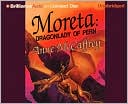

 |

|

The average rating for Moreta: Dragonlady of Pern (Dragonriders of Pern Series #7) based on 2 reviews is 3.5 stars.
Review # 1 was written on 2012-04-15 00:00:00 Rob Flury Rob FluryI've read a few of the other reviews, and I think many of the readers have missed the whole point of this book. One reader discusses in his review beginning writing skills taught in school - but completely missed the boat when it came to beginning comprehension skills. This story is not centered around a supposedly incurable virus. That virus is merely part of the setting. The climax of the story did not happen when the cure for the virus was discovered (as the above mentioned reviewer surmised). The climax happened when Moreta and her borrowed dragon did not return from "between." And that *did* happen closer to the end of the book. Perhaps some reviewers missed the title of the book itself - "Moreta: Dragonlady of Pern"? I will agree that perhaps there is an over aggressive use of names - it does get difficult to keep up with who is who and doing what at times, but the beauty of reading a book is that one can go back and reread if something gets confusing. The overarching theme of this book is one of completing a necessary mission no matter what the cost. Subthemes and lessons abound - such as be aware of one's surroundings, be sure one has what is needed to finish a task, putting one's people and their needs above one's own desires, etc. There is so much more to the story than what is in the words themselves. Go beyond - read between the lines. You'll get much more out of it. |
Review # 2 was written on 2007-07-09 00:00:00 Stuart Bazzle Stuart BazzleWhen I was a kid, I remember learning in English class about the parts of a narrative: Rising Action, Climax, and Denouement. The teacher illustrated this by drawing an equilateral triangle on the board, with the rising action on the left side and the falling action on the right, and the climax as the peak of the triangle. Did we all get taught this concept the same way? It didn't take me long to learn that this was absurdly wrong. The climax occurs very close to the end of the narrative, not in the middle. Well, apparently McCaffrey was taught the same way as I was, and apparently she took it to heart when it came to Moreta. The climax--such as it is--occurs midway through the book. The entire second half is a mopping up action, with little bogus crises thrown in to keep the plot lurching along. Once the plague is pretty much under control, the story is over, and the rest is just so much anticlimax. (And I'm sorry, but a novel centered around a disease, where the climactic moment is someone finding a cure in a book, is not much of a story under the best of circumstances.) (The following paragraph contains tiny, deliberately obscure spoilers, and details that will seem nonsensical if you haven't read the book.) While the Aftermath is powerfully written, the Great Ride alluded to in other Pern novels hardly seems necessary--if they can Time things, why not wait until tomorrow or the day after to do things? Why not take her time? [*rimshot*] And, for that matter, why keep the plan secret from the Weyrleaders? Well, because it necessitates Heroic Action on the part of the Dragonladies, of course, but it doesn't really make sense within the framework of Pern. If this is what the Masterhealer demands, then this is simply what must be done. Secrecy and going around behind the backs of the Weyrleaders seems unnecessary and contrived. Another aspect of MacCaffrey's writing that took me out of the plot was the incessant name-dropping in the first and final chapters. The first chapter names twenty-one different characters--oh yeah, I counted. In addition, eleven localities are mentioned by name, and four dragons. But this is nothing compared to the final chapter, in which SIXTY-TWO different characters are named, along with ten locales and TWENTY-FIVE different dragons. Most of these names, by the way, do not appear anywhere in the novel besides these two chapters. Here is an example from the last chapter, from page 302 of my edition: "'It's not something anyone admits to but T'grel must have to use it to cope with M'tani. Don't bother with L'bol at Igen. He's useless. Go directly to Dalova, Allaneth's rider. She lost a lot of bloodkin at Igen Sea Hold. She'd know who among her riders time it. And Igen has all those little cotholds stashed in the desert and on the riverbanks. Surely you've got a few good friends left at Ista. You were there ten Turns. Have you heard that F'gal's bad with kidney chill?'" Now it could be argued that the point here is to emphasize the scope--all the different people that Moreta must work with, and so forth. But this comes back to another bit of bad teaching. Every beginning writer has heard "Show, don't tell." Well this is not always true. When showing involved levels of detail that will break the narrative for the reader, good authors simply summarize the action. They tell us what happened instead of showing it to us. Readers fill in the gaps of time, and assume that the details we are not given are all in their proper place. Don't believe me? When was the last time you read about a character using the toilet? Do no characters use the toilet because all literary characters are constipated and dehydrated? Or do we merely assume that goes on without needing to be shown all the gory details? I'm sorry, but this is not merely bad writing, it's laughably bad writing. |
CAN'T FIND WHAT YOU'RE LOOKING FOR? CLICK HERE!!!